Everything About Robotic Knee Replacement
A robotic knee replacement is similar to a standard knee replacement in that it replaces the knee joint. Damaged tissue in your knee is removed and replaced with an artificial joint by your surgeon. The only difference is that it’s made with the help of a robotic arm.
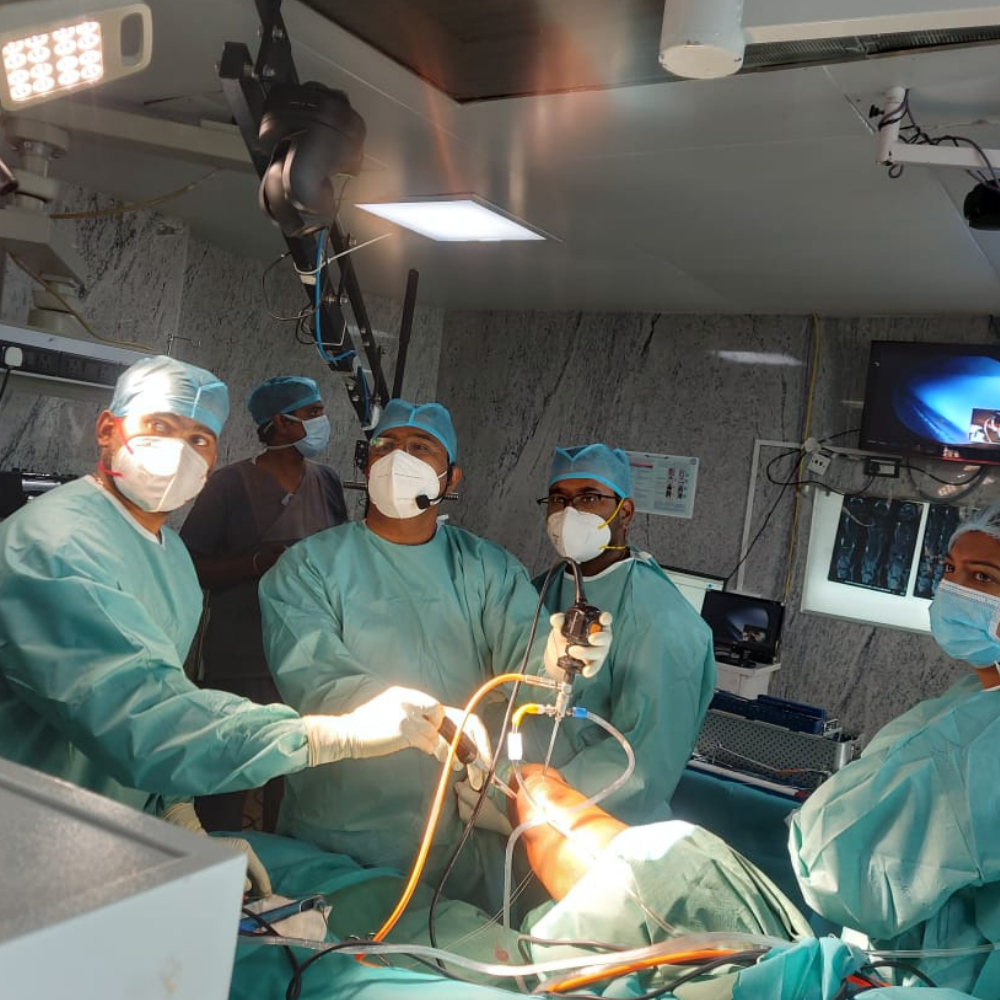
Everything About Robotic Total Knee Replacement and its Treatment
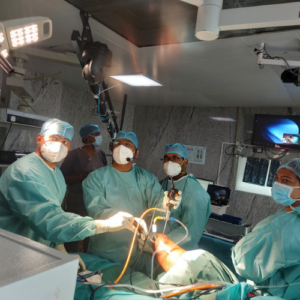
A robotic knee replacement is similar to a standard knee replacement in that it replaces the knee joint. Damaged tissue in your knee is removed and replaced with an artificial joint by your surgeon. The only difference is that it's made with the help of a robotic arm.
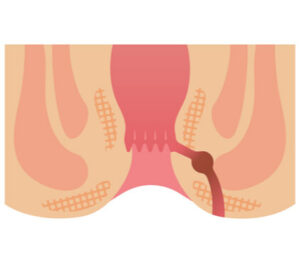
What is Anal Fistula?
A tunnel that extends from the anal opening and joins the skin surrounding it is known as an anal fistula. An infection that did not cure completely is the main cause of an anal fistula. Anus refers to the outer hole of a human body through which feces are expelled. Inside the anus are several tiny glands that produce mucus. An abscess may form when these glands get clogged and infected as a result of dirt and debris. These abscesses typically develop into an anal fistula.
What is Anal Fistula?
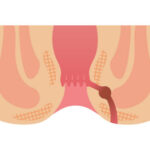
A tunnel that extends from the anal opening and joins the skin surrounding it is known as an anal fistula. An infection that did not cure completely is the main cause of an anal fistula. Anus refers to the outer hole of a human body through which feces are expelled. Inside the anus are several tiny glands that produce mucus. An abscess may form when these glands get clogged and infected as a result of dirt and debris. These abscesses typically develop into an anal fistula.
How does Anal fistula form?
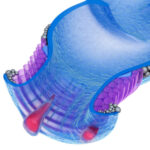
If the abscesses that occur near to and around the anal mucosal tissues are not treated, they usually continue to spread and get worse over time. The abscess eventually emerges like a hole that has entered the skin.
How does Anal fistula form?
If the abscesses that occur near to and around the anal mucosal tissues are not treated, they usually continue to spread and get worse over time. The abscess eventually emerges like a hole that has entered the skin.
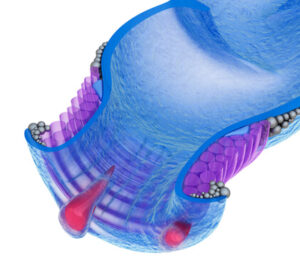
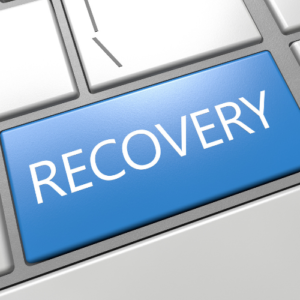
Recovery Rate
One month later, recovery The patient must follow to the surgeon's treatment instructions for at least one month following anal fistula surgery. The patient should avoid performing any actions that create stress on the surgery site. The patient should limit their intake of fatty and spicy foods and stick to foods high in fibre. The patient should regularly take sitz baths and keep the surgical area free of infection. 2 months later, recovery The patient would feel a significant reduction in pain at the operation location after two months. However, it can take some additional time for the scars to fade. The patient may resume regular eating habits and return to work without finding any significant difficulties. 3 months later, recovery The patient would be pain-free following surgery after three months. At the surgical location, there wouldn't be any scars, and the incision would also be fully healed.
Recovery Rate

One month later, recovery The patient must follow to the surgeon's treatment instructions for at least one month following anal fistula surgery. The patient should avoid performing any actions that create stress on the surgery site. The patient should limit their intake of fatty and spicy foods and stick to foods high in fibre. The patient should regularly take sitz baths and keep the surgical area free of infection. 2 months later, recovery The patient would feel a significant reduction in pain at the operation location after two months. However, it can take some additional time for the scars to fade. The patient may resume regular eating habits and return to work without finding any significant difficulties. 3 months later, recovery The patient would be pain-free following surgery after three months. At the surgical location, there wouldn't be any scars, and the incision would also be fully healed.
Causes
- Trauma to the anal tissues
- Infection in the anal gland
- Radiation from cancer treatment
- Crohn’s syndrome
- Sexually transmitted infection
- Tuberculosis
- Diverticulitis
Cancer
Symptoms
- Frequent anal abscesses
- pain and swelling around the anus
- Foul-smelling bloody drainage from the anal opening
- Bleeding along with stool
- Pain during bowel movements
- Fever, chills, and fatigue
Causes
- Trauma to the anal tissues
- Infection in the anal gland
- Radiation from cancer treatment
- Crohn’s syndrome
- Sexually transmitted infection
- Tuberculosis
- Diverticulitis
- Cancer
Symptoms
- Frequent anal abscesses
- pain and swelling around the anus
- Foul-smelling bloody drainage from the anal opening
- Bleeding along with stool
- Pain during bowel movements
- Fever, chills, and fatigue
Diagnosis
An anorectal specialist can typically identify an anal fistula by a simple physical examination. Your rectum and anal canal may need to be examined by the doctor if the anal fistula is in severe condition. The following procedures are frequently used to identify anal fistulas:
Digital examination- During this test, the fistula expert inserts a finger into the rectum while wearing gloves and lubricant to look for any abnormal growth.
Visual inspection – A proctoscope, an anoscope, or a sigmoidoscope may be used by the proctologist or anorectal surgeon to visually investigate the lower rectum. The doctor will thoroughly inspect the lining of your anal tissues using one of these tools to determine the severity and depth of your anal fistula.
Anoscopy – Annoscopy allows the anorectal physician to look around your anus and rectum. The review looked for unnatural growths, bleeding, inflammatory changes, and diseases like diverticulosis.
Sigmoidoscopy – Flexible sigmoidoscopy is a helpful test to seek for a fistula-in-underlying Eno’s etiology.
Imaging studies – To obtain a clearer look at the fistula tract, your doctor might also recommend an ultrasound or MRI of the anal region.
If you are aware of the symptoms, it is not very difficult to self-diagnose an anal fistula. If you suspect you have hemorrhoids, you may almost certainly confirm it by examining the anal region and looking for any abnormalities close to the anal orifice. If you have an anal fistula, your anal skin will likely be constantly itchy, which will make it challenging for you to sit or use the toilet seat. Additionally, you can suffer an uncomfortable discharge from or close to your anus, and on rare occasions, you might even pass blood with your feces. Additionally, you may feel a high fever and have swelling and redness in your anal region.
Anal fistulas are typically diagnosed primarily through physical examination by proctologists or anorectal surgeons. In order to better understand your illness and choose the most appropriate course of therapy, the doctor may ask you a few questions when you first arrive at the clinic.
Do you have a history of anal fistula in your family?
When did the symptoms first appear?
Does your stool contain blood?
What are your eating and living practises?
What kind of exercise do you do?
When do you experience discomfort the most?
In order to determine the severity of the fistula tract and to identify the internal openings, the doctor could also perform a digital rectal examination. A colonoscopy, sigmoidoscopy, or anoscope may be recommended by the proctologist in order to look for any gastrointestinal diseases. In these examinations, the physician inserts a tiny camera to look for any anus, rectum, and colon anomalies. In some circumstances, the doctor might additionally advise flexible sigmoidoscopy to see if the fistula has any secondary branches, which are fistulas with a single internal entrance but several exterior openings.
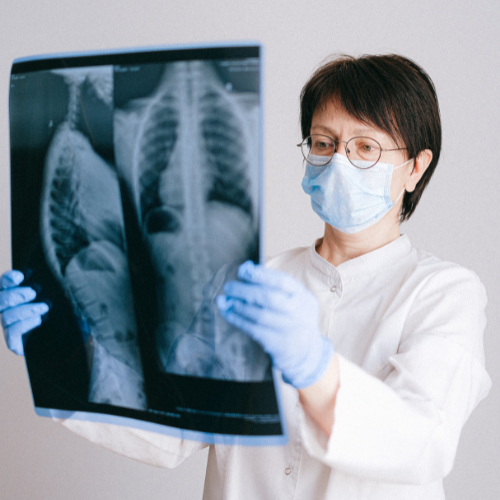
Diagnosis
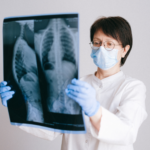
An anorectal specialist can typically identify an anal fistula by a simple physical examination. Your rectum and anal canal may need to be examined by the doctor if the anal fistula is in severe condition. The following procedures are frequently used to identify anal fistulas:
Digital examination- During this test, the fistula expert inserts a finger into the rectum while wearing gloves and lubricant to look for any abnormal growth.
Visual inspection – A proctoscope, an anoscope, or a sigmoidoscope may be used by the proctologist or anorectal surgeon to visually investigate the lower rectum. The doctor will thoroughly inspect the lining of your anal tissues using one of these tools to determine the severity and depth of your anal fistula.
Anoscopy – Annoscopy allows the anorectal physician to look around your anus and rectum. The review looked for unnatural growths, bleeding, inflammatory changes, and diseases like diverticulosis.
Sigmoidoscopy – Flexible sigmoidoscopy is a helpful test to seek for a fistula-in-underlying Eno’s etiology.
Imaging studies – To obtain a clearer look at the fistula tract, your doctor might also recommend an ultrasound or MRI of the anal region.
If you are aware of the symptoms, it is not very difficult to self-diagnose an anal fistula. If you suspect you have hemorrhoids, you may almost certainly confirm it by examining the anal region and looking for any abnormalities close to the anal orifice. If you have an anal fistula, your anal skin will likely be constantly itchy, which will make it challenging for you to sit or use the toilet seat. Additionally, you can suffer an uncomfortable discharge from or close to your anus, and on rare occasions, you might even pass blood with your feces. Additionally, you may feel a high fever and have swelling and redness in your anal region.
Anal fistulas are typically diagnosed primarily through physical examination by proctologists or anorectal surgeons. In order to better understand your illness and choose the most appropriate course of therapy, the doctor may ask you a few questions when you first arrive at the clinic.
Do you have a history of anal fistula in your family?
When did the symptoms first appear?
Does your stool contain blood?
What are your eating and living practises?
What kind of exercise do you do?
When do you experience discomfort the most?
In order to determine the severity of the fistula tract and to identify the internal openings, the doctor could also perform a digital rectal examination. A colonoscopy, sigmoidoscopy, or anoscope may be recommended by the proctologist in order to look for any gastrointestinal diseases. In these examinations, the physician inserts a tiny camera to look for any anus, rectum, and colon anomalies. In some circumstances, the doctor might additionally advise flexible sigmoidoscopy to see if the fistula has any secondary branches, which are fistulas with a single internal entrance but several exterior openings.
Risks & Complications
Surgery for an anal fistula may carry risks and problems, just like any other surgical procedures. Some such issues include:
Infection – Every surgery carries some risk of infection when incisions are made in the skin. The same is true of the fistulectomy surgery. When the fistula tract is excessively deep, the surgeon may occasionally need to execute the procedure in stages. In that situation, there is a significant chance that the fistula will spread to other parts of the body and result in a systemic infection. The doctor might recommend antibiotics in the event of an infection caused by an anal fistula. If the infection is sufficiently bad, the patient could possibly need to be admitted to the hospital and receive antibiotics intravenously.
Bowel incontinence – The anal sphincter muscles may suffer injury if the fistula surgery is not carried out by a skilled anorectal surgeon. The muscles of the anal sphincter are in charge of maintaining the anus and regulating bowel movements. In any case, if the sphincter muscles are broken, the anal muscles’ power is weakened, which could result in faeces leaking. Bowel incontinence is the term for this condition. According to estimates, 3–7 percent of all patients undergoing anal fistula surgery suffer from bowel incontinence.
Anal fistula recurrence – It is estimated that 7 to 21% of individuals who have surgery for an anal fistula experience a recurrence of the condition after the procedure. In the event of anal fistula treatment, the likelihood of recurrence is ten times higher.
It is best to start therapy as soon as you are diagnosed with any anorectal condition, including an anal fistula. Home remedies should not be depended upon for an extended period of time if you have been diagnosed with anal fistula or any other anorectal condition, according to a senior proctologist at aasra. The severity of symptoms including discomfort, swelling, soreness, redness, and inflammation in the anal region can only be lessened using home treatments. Surgery is the only option that is both the safest and effective for a permanent cure.
Anal fistula can result in the following consequences if left untreated:
Unbearable pain- If left untreated, a fistula in the anal region can result in excruciating pain. With time, the pain may worsen, and the illness itself may be difficult to treat. Untreated anal fistula may result in unpleasant-smelling anal discharge that might interfere with your daily activities and lead you to feel self-conscious
unable to move or sit down – You may have discomfort when sitting or moving about if you have a disease like anal fistulas. It is therefore advisable to have surgery as soon as you are given a diagnosis for one of them.
Extension of anal fistulas – If left untreated, an internal anal sphincter muscle, which keeps your anus closed, may become infected. Such situations make it harder for the fissure to heal and can result in excruciating pain and suffering that need both medical treatment and surgical intervention.
Delaying treatment for anal fistulas may also result in the following complications:
With bowel movements, severe pain
around and around the anus, there is a burning and itching feeling
pus dripping from the anus
skin tags or lumps developing in the anal region
the formation of anal ulcers.

Here are some tips for avoiding an anal fistula:
Consuming a high-fiber diet is one of the simplest strategies to avoid developing an anal fistula. The best course of action is to add more fiber-rich foods to your diet in order to avoid having hard bowel movements. Eat at least 25 to 30 grammes of fibre each day if you don’t want to develop an anal fistula. Several foods high in fibre include:
Oatmeal, brown rice, and whole grains
lentils and beans
Brussel sprouts with vegetable
Bananas, apples, pears, berries, and other fruits
- Drink sufficient water- A fiber-rich diet and water are both crucial for preventing any anorectal diseases. Enough water consumption reduces the need to strain when urinating by preventing constipation and hard stools. It is crucial to consume adequate water throughout the day to prevent anal fistula. Your digestive system will work more efficiently as a result.
- Maintain cleanliness and dryness in your anal region –Anal fistula frequently develops as a result of obstructions in the anal canal. The development of an anal fistula is caused by the long-term accumulation of dirt and waste. Every time you have a bowel movement, you must clean the anal area in order to avoid this. After cleaning, dry the area thoroughly to prevent the growth of bacteria or an illness.
- Don’t strain while passing stool –Avoid straining when going to the bathroom. Straining has the potential to worsen the anal skin’s condition and aggravate the anal fistula. Equally crucial is to watch out not to spend too much time sitting on the toilet seat. You are more likely to strain while making your bowel motions worse the longer you sit on the toilet seat.
- Exercise on a regular basis — Physical activity and how you maintain your body active are directly related to almost all anorectal disorders. Maintaining an active lifestyle maintains the colon healthy and functioning normally. Having said that, you should be aware of which forms of exercise are beneficial to you and which are not. Avoid engaging in any activity that strains or presses on your abdomen. Don’t do weightlifting. Don’t spend hours sitting still in one area. Regularly engage in mild physical activity.
The majority of people are now aware that anal fistulas can be treated most effectively using laser therapy or anal fistulas, according to several anorectal surgeons. People have misconceptions about the treatment that they take as gospel. Let’s dispel the myths and provide you with more information about the therapy approach.
Myth 1: The anal sphincter muscles may become damaged during laser treatment for an anal fistula.
Fact-check: Of all surgical treatments, laser surgery is the most successful and safest option. Laser surgery is cutting-edge, leaves no scars or bleeding, and the patient feels no pain. The procedure can be highly depended upon if carried out by a qualified anorectal specialist as it guarantees that no organs are damaged.
Myth 2: Laser therapy is extremely expensive and unaffordable.
Factual statement: The expense of the treatment is significantly more than that of traditional open operations because it is far more sophisticated and effective. But it’s unquestionably not out of reach. You can receive the greatest proctologists’ laser anal fistula surgery at Pristyn Care for a very affordable price.
Myth 3: You must take a lot of time off after laser surgery to fully recuperate.
Fact: The reverse is true in reality. Compared to other forms of treatment, the recovery after laser surgery is more quicker and more flawless. Laser surgery has a far faster recovery period than other surgical procedures because there are no incisions, stitches, or blood loss.
Risks & Complications
Surgery for an anal fistula may carry risks and problems, just like any other surgical procedures. Some such issues include:
Infection – Every surgery carries some risk of infection when incisions are made in the skin. The same is true of the fistulectomy surgery. When the fistula tract is excessively deep, the surgeon may occasionally need to execute the procedure in stages. In that situation, there is a significant chance that the fistula will spread to other parts of the body and result in a systemic infection. The doctor might recommend antibiotics in the event of an infection caused by an anal fistula. If the infection is sufficiently bad, the patient could possibly need to be admitted to the hospital and receive antibiotics intravenously.
Bowel incontinence – The anal sphincter muscles may suffer injury if the fistula surgery is not carried out by a skilled anorectal surgeon. The muscles of the anal sphincter are in charge of maintaining the anus and regulating bowel movements. In any case, if the sphincter muscles are broken, the anal muscles’ power is weakened, which could result in faeces leaking. Bowel incontinence is the term for this condition. According to estimates, 3–7 percent of all patients undergoing anal fistula surgery suffer from bowel incontinence.
Anal fistula recurrence – It is estimated that 7 to 21% of individuals who have surgery for an anal fistula experience a recurrence of the condition after the procedure. In the event of anal fistula treatment, the likelihood of recurrence is ten times higher.
It is best to start therapy as soon as you are diagnosed with any anorectal condition, including an anal fistula. Home remedies should not be depended upon for an extended period of time if you have been diagnosed with anal fistula or any other anorectal condition, according to a senior proctologist at aasra. The severity of symptoms including discomfort, swelling, soreness, redness, and inflammation in the anal region can only be lessened using home treatments. Surgery is the only option that is both the safest and effective for a permanent cure.
Anal fistula can result in the following consequences if left untreated:
Unbearable pain- If left untreated, a fistula in the anal region can result in excruciating pain. With time, the pain may worsen, and the illness itself may be difficult to treat. Untreated anal fistula may result in unpleasant-smelling anal discharge that might interfere with your daily activities and lead you to feel self-conscious
unable to move or sit down – You may have discomfort when sitting or moving about if you have a disease like anal fistulas. It is therefore advisable to have surgery as soon as you are given a diagnosis for one of them.Extension of anal fistulas – If left untreated, an internal anal sphincter muscle, which keeps your anus closed, may become infected. Such situations make it harder for the fissure to heal and can result in excruciating pain and suffering that need both medical treatment and surgical intervention.
Delaying treatment for anal fistulas may also result in the following complications:With bowel movements, severe pain
around and around the anus, there is a burning and itching feeling
pus dripping from the anus
skin tags or lumps developing in the anal region
the formation of anal ulcers.

Here are some tips for avoiding an anal fistula:
Consuming a high-fiber diet is one of the simplest strategies to avoid developing an anal fistula. The best course of action is to add more fiber-rich foods to your diet in order to avoid having hard bowel movements. Eat at least 25 to 30 grammes of fibre each day if you don’t want to develop an anal fistula. Several foods high in fibre include:
Oatmeal, brown rice, and whole grains
lentils and beans
Brussel sprouts with vegetable
Bananas, apples, pears, berries, and other fruits
- Drink sufficient water- A fiber-rich diet and water are both crucial for preventing any anorectal diseases. Enough water consumption reduces the need to strain when urinating by preventing constipation and hard stools. It is crucial to consume adequate water throughout the day to prevent anal fistula. Your digestive system will work more efficiently as a result.
- Maintain cleanliness and dryness in your anal region –Anal fistula frequently develops as a result of obstructions in the anal canal. The development of an anal fistula is caused by the long-term accumulation of dirt and waste. Every time you have a bowel movement, you must clean the anal area in order to avoid this. After cleaning, dry the area thoroughly to prevent the growth of bacteria or an illness.
- Don’t strain while passing stool –Avoid straining when going to the bathroom. Straining has the potential to worsen the anal skin’s condition and aggravate the anal fistula. Equally crucial is to watch out not to spend too much time sitting on the toilet seat. You are more likely to strain while making your bowel motions worse the longer you sit on the toilet seat.
- Exercise on a regular basis — Physical activity and how you maintain your body active are directly related to almost all anorectal disorders. Maintaining an active lifestyle maintains the colon healthy and functioning normally. Having said that, you should be aware of which forms of exercise are beneficial to you and which are not. Avoid engaging in any activity that strains or presses on your abdomen. Don’t do weightlifting. Don’t spend hours sitting still in one area. Regularly engage in mild physical activity.
The majority of people are now aware that anal fistulas can be treated most effectively using laser therapy or anal fistulas, according to several anorectal surgeons. People have misconceptions about the treatment that they take as gospel. Let’s dispel the myths and provide you with more information about the therapy approach.
Myth 1: The anal sphincter muscles may become damaged during laser treatment for an anal fistula.
Fact-check: Of all surgical treatments, laser surgery is the most successful and safest option. Laser surgery is cutting-edge, leaves no scars or bleeding, and the patient feels no pain. The procedure can be highly depended upon if carried out by a qualified anorectal specialist as it guarantees that no organs are damaged.
Myth 2: Laser therapy is extremely expensive and unaffordable.
Factual statement: The expense of the treatment is significantly more than that of traditional open operations because it is far more sophisticated and effective. But it’s unquestionably not out of reach. You can receive the greatest proctologists’ laser anal fistula surgery at Pristyn Care for a very affordable price.
Myth 3: You must take a lot of time off after laser surgery to fully recuperate.
Fact: The reverse is true in reality. Compared to other forms of treatment, the recovery after laser surgery is more quicker and more flawless. Laser surgery has a far faster recovery period than other surgical procedures because there are no incisions, stitches, or blood loss.
When to consult a doctor ?
The majority of people frequently neglect the early signs of an anal fistula. If you are unaware of the disease's symptoms, you may not know when to see the appropriate doctor. Getting medical care and expert assistance can help you prevent serious complications of the condition from occurring sooner. Any of the following symptoms could be a clue that you have an anal fistula. In that circumstances, you should speak with an anorectal surgeon right away:
- If you see or smell foul discharge coming from your anal region.
- Consult a doctor as soon as possible if you notice blood in your faeces or on the tissue or toilet seat. Not just fistula-in-ano, but other anorectal diseases, can present with blood in the stool as a common symptom. Therefore, it is necessary to discuss this symptom with a doctor in order to assess the situation and choose the most appropriate course of action.
- When no medication and home remedies provide you relief or effective results from your symptoms.
Our Specialist

***
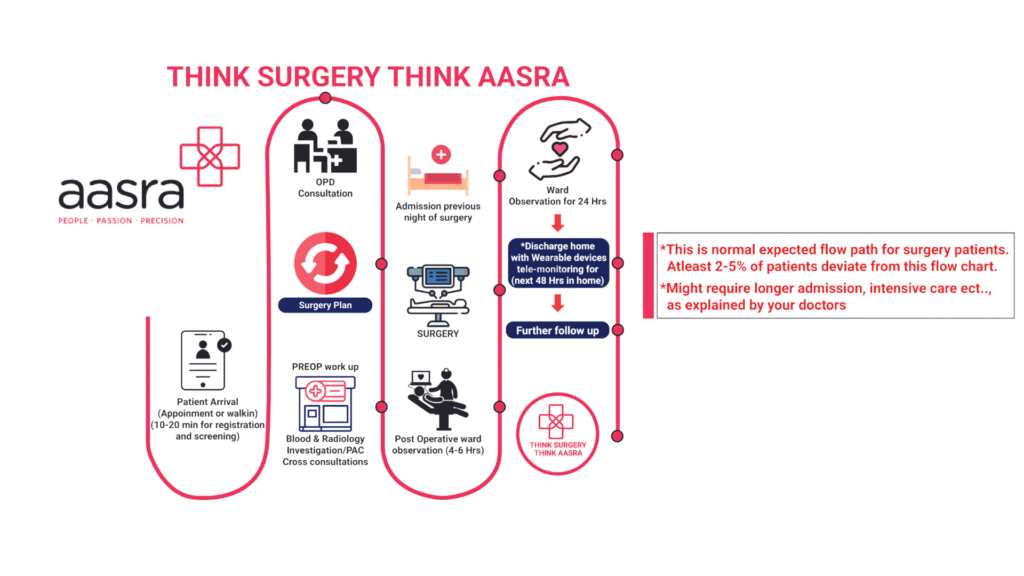
When to consult a doctor ?
The majority of people frequently neglect the early signs of an anal fistula. If you are unaware of the disease's symptoms, you may not know when to see the appropriate doctor. Getting medical care and expert assistance can help you prevent serious complications of the condition from occurring sooner. Any of the following symptoms could be a clue that you have an anal fistula. In that circumstances, you should speak with an anorectal surgeon right away:
- If you see or smell foul discharge coming from your anal region.
- Consult a doctor as soon as possible if you notice blood in your faeces or on the tissue or toilet seat. Not just fistula-in-ano, but other anorectal diseases, can present with blood in the stool as a common symptom. Therefore, it is necessary to discuss this symptom with a doctor in order to assess the situation and choose the most appropriate course of action.
- When no medication and home remedies provide you relief or effective results from your symptoms.
Our Specialist

***
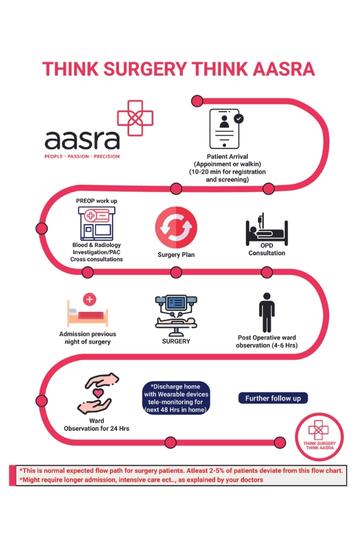

Insurance coverage
Insurance does cover the cost of the surgical procedure for a hysterectomy performed due to adenomyosis because it is on the list of procedures that are "medically required." The cost capping, however, may change from instance to case. Please get your healthcare or insurance company to validate this.
Insurance coverage

Insurance does cover the cost of the surgical procedure for a hysterectomy performed due to adenomyosis because it is on the list of procedures that are "medically required." The cost capping, however, may change from instance to case. Please get your healthcare or insurance company to validate this.
Frequently Asked Questions
Frequently Asked Questions
Facts and figures around robotic hip replacement
Why choose Aasra for robotic knee replacement treatment?
AASRA Hospital has the state of the art technology for performing joint replacement surgeries i,e MAKO Robitic joint replacement technology.
There is less post operative pain, reduced hospital stay ,patient can walk early and early recovery .
How to book appointment for aasra
Booking an appointment with a Aasra Orthopedician is easy.
Simply give us a call directly or complete our online appointment booking form. The only four questions it would ask you are “Your name,” “Contact,” and “tell us a little more about yourself.” Simply complete the form and press “submit.” One of our medical coordinators will give you a call soon to assist you in speaking with the doctor of your choice.
Facts and figures around robotic hip replacement
Why choose Aasra for robotic hip replacement treatment?
AASRA Hospital has the state of the art technology for performing joint replacement surgeries i,e MAKO Robitic joint replacement technology.
There is less post operative pain, reduced hospital stay ,patient can walk early and early recovery .
How to book an appointment for aasra?
Booking an appointment with a Aasra Orthopedician is easy.
Simply give us a call directly or complete our online appointment booking form. The only four questions it would ask you are “Your name,” “Contact,” and “tell us a little more about yourself.” Simply complete the form and press “submit.” One of our medical coordinators will give you a call soon to assist you in speaking with the doctor of your choice.
Questions to ask your doctor.
Treatment options & cost
- Fibrin glue – Fibrin glue is a therapeutic for anal fistulas which activates thrombin to form a fibrin cloth. The procedure helps close the fistula tract mechanically. Fibrin glue is a liquid sealant thought to assist in fistula tract healing by stimulating migration and activation of fibroblasts.2 It is a tempting treatment modality: the technique is simple, repeatable, and involves only minor surgical trauma to the anal sphincter. Fibrin glue treatment is very easy to use and is considered as a good treatment for people who are not in favor of surgery. However, fibrin glue is not the best replacement for skilled anorectal surgery.
- Seton placement – This procedure involves placing a suture or a rubber band (also known as seton) in the anal fistula that is progressiveley tightened. The rubber band lets the fistula heal behind the seton. The treatment is non-invasive and the risk of recurrence is also quite low.
Once you have developed anal fistula, antibiotics or home remedies alone will not cure the condition. You will require surgical intervention to get the condition treated. Surgical options for anal fistula treatment include:
- Fistulotomy – In this treatment, the fistula is opened and allowed to heal from inside out. The surgery is usually an outpatient procedure. As such, the patient can return home the very same day.
- Laser surgery for snal fistula – Laser treatment for the closure of fistula-in-ano is a minimally invasive and low-complication treatment which is considered as the most effective treatment for complex fistulas. The treatment does not cause any severe damage or injury to the sphincter muscles.
There’s no denying that if you have developed anal fistula, the best thing to do is get professional help. But additionally, you can include self-care measures in your daily regime that may not only aid in reducing the symptoms but also help the fissure heal in a much shorter time.
Sitz baths – Sitz baths is one of the highly beneficial home remedy for almost every anorectal problem including anal fistula. Sitz baths may help in not only reeieving pain of the anal area but also speed up th ehealing process. Sitz bath is basically feeling a palstic tub with warm water and soaking you anal area for 15-20 minutes in the wtaer. The tubs used for the treatment can be brought from any drugstore. You can add epsom salts and additives in the water too, but only after recommendation from your healthcare provider.
Eating more fiber – If you have any anorectal disease or disorder, eating a sufficient amount of fiber may help prevent stools from being hard and prevent constipation and diarrhea. FIber rich diet can aid you in passing stools easily which may be less traumatic to the anal opening. Some examples of fiber-rich food are:
- Beans
- High-fiber bran cereal
- Split peas
- Chickpeas
- Lentils
- Pigeon peas
- Wheat bran flakes
- Avocados
- Soybeans
Use stool softeners – Using stool softener may prevent complications such as constipation. Stool softeners usually are quite effective in case of any anorectal diseases and cause no side effects. Stool softeners pull more water into the digestive tract that softens the stool. However, most doctors do not recommend using stool softeners for more than a week or ten days. Once you stop using stool softeners, it is important that you make lifestyle changes and continue healthy food.
- Take care of the perianal skin – You want to prevent or maage anal fistula? The trick is to keep your perianal skin clean after bowel movements. If the jet spray is hurting your skin, you can skin the area with wet wipes. Make sure to rub or pat dry the area after passing stool each time. Remember to be gentle with your skin.
Anal fistula surgery is not a very complicated treatment and as such requires no thorough preparation. The preparation is even simpler in case of lser surgery for anal fistula. But like any other surgery, of complications/ side effects in case of suregry for anal fistula too. Hence, you need to follow the doctor’s instructions to ensure that your surgery goes well and you recover without any complications. Before your surgery for anal fistula:
- Do not eat or drink anything heavy. Eat a very light meal, preferably only breakfast.
- Do not drink any form of carbonated or caffeinated drinks, just consume clear liquids at least for 5 hours before the surgery.
- If you are on any anti-inflammatory, allergy medicines or any blood thinners, the doctor will recommend you to stop it as soon as possible before the treatment.
- Stop smoking and drinking alcohol. It will help you heal faster after the surgery.
The recovery route after anal fistula surgery is usually simple with no major complications. If you diligently follow the doctor’s recommendations and tips, you will not experience any complications. Here are a few tips that can help you heal and recover easily after anal fistula surgery:
- Eat a high-fibre diet.
- Avoid lifting heavyweights.
- Use a stool softener that can aid you in having smooth bowel movements.
- Stay hydrated. Drink at least 8-10 glasses of water every day.
- Do not strain while passing a stool.
- Cost of anal fistula surgery in Delhi – Rs. 40,000 to Rs. 50,000
- Cost of anal fistula in Bangalore – Rs. 38,000 to Rs. 52,000
- Cost of anal fistula in Gurgaon – Rs. 40,000 to Rs. 50,000
- Cost of anal fistula in Pune – Rs. 35,500 to Rs. 45,000
- Cost of anal fistula in Jaipur – Rs. 37,000 to Rs. 45,000
- Cost of anal fistula in Bhopal – Rs. 40,000 to Rs. 50,000
- Cost of anal fidstula in Coimbatore – Rs. 40,000 to Rs. 5,000
FAQ
If you have anal fistula, you are likely to experience these signs and symptoms:
- itching and irritation in anal skin
- pain & swelling
- irritation
- bright red color bleeding
- foul-smelling pus drainage
Usually, anorectal surgeons take around 1-3 hours to complete anal fistula surgery. However, the operation time may increase or decrease depending on factors like:
- Age of the patient
- Type of anal fistula surgery/treatment planned to perform
- Size and severity of anal fistula
- Presence of any underlying anorectal disease or disorder
The success rate of anal fistula suregry can be as high as 95 percent if the suregry is performed by an epxert surgeon. The success of the surgery, post-surgery complications and possible recurrence of the condition, everything depends on how well the patient follows the advice of the doctor too.
To book an appointment with Pristyn Care doctors for the treatment of anal fistula, you can either call us directly on the number emntioned on the page or fill the appointment form. Our medical representative will get back to you to schedule an appointment as per your convenience with an expert anorectal surgeon.
Nitroglycerin cream can provide temporary relief from anal fistula symptoms as it improves blood flow and speed up the healing process. It can be directly applied to the anal canal after dilution to get relief from symptoms of fistula. But the ointment should be used only after consulting with the doctor. However, it is to be kept in mind that no ointment can provide permanent cure to anal fistula. If you are diagnosed with the condition, you will need surgery sooner or later to permanently get rid of the condition.
Yes. Exercise can help to regulate your bowel movements and make symptoms of ana fistula less painful. Along with exercise, you must drink plenty of water to prevent constipation and aid your bowel movement. Exercise also improves the blood flow to the anal region that can help the fistula to heal properly once it is cleaned.
No. Laser fistula surgery is a painless and non-invasive treatment method. There won’t be any cuts, stitches, wounds, or scars involved in the procedure. The treatment is also carried out under anesthesia (either general or local depending on the patient) which means the patient will not feel any pain or discomfort during the surgery. Once the effects of the surgery wear off, the patient may feel a slight painful sensation at the surgical site which is completely normal. The doctor, most likely, would prescribe medicines to help ease the pain. With proper medication and ample rest, the pain is likely to fade within the next few days only.
Facts and figures around Piles
- Facts and figures around anal fistula:
- Medical studies state that 23% of Indians have anal fistula.
- 28% of individuals with anal abscess and 12% of individuals with underlying anal diseases have developed anal fistulas.
- Each year between 50,000 to 1,00,000 women worldwide are affected by obstetric fistula.
- Approximately 76% of patients with anal fistula preferred to undergo laser surgery, 14% choose to undergo open surgery, and the remaining 10% choose to follow home remedies, lifestyle changes, and dietary modifications.
Why choose Aasra Care for anal fistula surgery?
- Aasra Care is a certified Centre of Excellence for anorectal treatments including diseases like anal fistula, piles and anal fissure.
- Aasra Care houses some of the top anorectal surgeons of the country who have years of experience in delivering surgical treatment for colorectal diseases with a high success rate.
- Aasra Care is associated with some of the top hospitals across India that are equipped with state-of-the-art facilities required to perform advanced anorectal surgeries.
- Proctologists/ General Surgeons working with Aasra Care do a thorough consultation in the case of every patient to understand the health condition and then determine the treatment method that will work best.
- A dedicated ‘care buddy’ is assigned to every patient on the day of the surgery. We strive to make the whole surgical experience for our patients a seamless one. Once you reach the hospital, your dedicated medical attendant or ‘care buddy’ will take care of every paperwork and formality on your behalf.
- To ease out the commuting process for our patients, we also provide free cab facilities to bring you from home to the hospital and help you return back home after the surgery.
- A free-of-cost follow-up is provided to the patients within the first seven days after the anal fistula surgery.
